Letter 51: FantasyTop
Literally everything you could possibly want to know about the game taking Crypto Twitter by storm
I swear 90% of my Newsletters start with “unless you’ve been living under a rock…” but seriously, unless you’ve been living under a rock for this past week, you must surely have been relentlessly exposed to the hot new SocialFi game on Blast called FantasyTop.
I am utterly obsessed with it. I’m having more fun than I have in a very long time in this space by basically eating/sleeping/breathing all things FT. It’s a fascinating game with a lot of layers, strategy, and complexity which (to me) makes it very fun, but this can also make it difficult for a person to wrap their head around.
There’s an oft quoted poker saying that says “Texas Hold’em takes 10 minutes to learn and a lifetime to master”, and I think that applies the same to something like Fantasy Sports.
So that’s what this is for. I’m gonna start off by explaining things as simply as possible and hopefully get everyone up to a base level of understanding of wtf it is and how one can play and get involved (if they so desire), and then we’re gonna go deep into oh so much more.
Alright let’s get started with the veeeery basics.
What Is Daily Fantasy Sports?
FantasyTop (FT) is what’s classified as a Daily Fantasy Sports game. Most people are probably familiar with Fantasy Sports which is basically where you get to draft an imaginary team of players from a particular sport which then get points based on their performance, and you’re competing against other people who draft their own teams. Whoever gets the most points at the end of the season wins.
Daily Fantasy Sports is the same concept only accelerated. It started popping up around 15 years ago with the idea being that our society-wide-ADHD-riddled-brains with no attention spans couldn’t fathom waiting an entire season for results, so what if we made tournaments last only a day or maybe a week at most?
And thus a new and faster-paced age of Fantasy Sports was ushered in.
So what is FantasyTop then?
Disclosure: I am an angel investor in FantasyTop and an active player with 500+ cards that I purchased with my own funds.
FT basically takes this same concept but applies it to Crypto Twitter. Instead of choosing from NFL or Basketball players, you choose from people in the crypto space that are active on Twitter (X). You can call these would-be-players KOLs, content creators, influencoooors or whatever you want — but in the game they’re called Heroes.
To play the game you draft a team or “deck” of 5 heroes and enter them into a tournament, and your deck is pitted against everyone else’s. Tournaments come in different shapes and sizes and will usually last anywhere from 2-5 days. There are prizes given out depending on where you finish in the tournament (including participation rewards).
Heroes get points based on their engagement on Twitter. The exact algorithm isn’t known and isn’t likely to ever be fully known (to prevent gaming the system / bot issues), and it’s regularly being updated in any event. The gist is, the more views and engagement a person is getting = the better (and there are mechanisms to equalize it so an account with 20k followers can compete with an account with 500k followers).
Things get (more) interesting when you realize that every Hero is an NFT, and in order to play them in your deck, you need to own their card. There is a different supply # for every Hero, some only have 50 cards, others have 10k+. You can acquire these Hero cards either by buying “packs” which have 5 random cards, buying individual cards on the secondary market from other players, winning cards as prizes in tournaments, and there will (i believe) likely soon be 1-2 ways to acquire cards that are luck based and don’t require capital.
There are currently 123 Heroes playing the game and the team plans to add more every couple of weeks.
That’s… basically the broad strokes. You should now hopefully at least kinda “get” what the game is. If you’re interested enough to read more, i’m probably gonna spend 8 billion words explaining things in more detail + discussing how I am thinking about the game (and the meta-game) on a strategic level, but if you stop reading here I promise I won’t be offended.
Hero Cards
Alright I think the most logical place to begin to dig deeper on are the Hero cards. They are front and center and basically what make the game the game.
In order for a person to have their card in the game, they have to grant their permission. How the team decides who they want to ask to be a Hero is (currently) entirely at their discretion, but they’ve hinted at allowing people to vote for who they want in the future.
In general I imagine they want accounts with a reasonable following (probably like 5-10k is the minimum range if I had to guess), and ones who are keen and excited to be involved and play the game.
There are some great benefits of being a hero. There are also some fairly significant downsides.
As a hero myself I can share my perspective on the pros and cons, but obviously can’t speak for the others.
Financially all the heroes are rewarded for participating in the game. Whenever any card is traded on the secondary market, there’s a 3% royalty fee. Half of that fee goes to the hero who’s card is being traded. In addition to this, 10% of the revenue that comes from pack purchases is equally distributed among every hero.
This can be a sizable amount — the first payout was 3-7 ETH per hero. It was probably a massive anomaly given it was the first week with probably the most packs that’ll ever be purchased in a week and I don’t think we see numbers that high again, but still, Heroes could theoretically make 1-2 ETH per month from this on a relatively consistent basis. If all goes well and the whole thing doesn’t collapse in a fiery blaze that is ofc.
Some downsides of being a hero are that it can create a sense of pressure to perform well for your card holders. You might (you will) get people who put you in your deck and then get angry at you for not tweeting enough, not engaging enough, etc etc etc. It can be pretty rough and I do not recommend being a hero for the faint of heart. Anyone with social anxiety or mental health difficulties / self-image issues should probably stay away.
Card Stars & Rarity
The first thing you’ll notice when you look at any hero card are that they all have a number of stars at the top (ranging from 2* to 7*), and they all also have a rarity ranking: common, rare, epic, or legendary:
The star ranking is dynamic and changes every week based on the performance of the hero. Basically, every hero has a 7-day rolling points score which determines their rank (#1 rank always has 1000 points and everyone else has some amount lower than that).
Points are determined by “the algorithm”, which will take into account a heroes genuine twitter engagement (views) as well as the quality of their views (aka a million views from bots would be worth less than a single view from vitalik). It’s also weighted towards people within the crypto space for now.
Every week they do an “update” to the metadata/star rankings and if a hero has moved up in ranking, they might get more stars. If a hero has moved down, they might lose stars.
The number of stars is largely aesthetic and doesn’t actually impact the gameplay. I always recommend looking at stars as a historic metric of how the hero has been performing in the recent past, but it isn’t necessarily indicative of how well they’ll do for you moving forward.
The rarity on the other hand has a direct impact on every tournament. Basically as a card increases in rarity, they get a multiplier on any points they earn during a tournament. The multipliers are as follows:
Common: 1x
Rare: 1.5x
Epic: 2x
Legendary: 2.5x
During a tournament the most base-points a hero can get is 1000. So if you have the #1 hero in the tournament as a common card, you’re receiving 1000 points from them. If someone else has a Legendary rarity card who is only getting 400 base points because they’re getting far less engagement, they actually end up being worth the same amount of points after the multiplier takes effect.
There are two ways to get rarer cards. The first is due to luck - whenever you open a pack, there’s a small % chance you’ll pull a rare/epic/legendary, but most of the time the cards you get will all be common.
The other way is by burning/upgrading your cards. At any time you can burn 5 cards to upgrade to a new card of higher rarity, almost always moving one level up with a tiny chance of getting lucky again and moving up further. The odds are as follows:
Burn 5 common cards and have a 98.9% chance to get to Rare, a 1% chance to get an Epic, and a 0.1% chance to get a Legendary.
Burn 5 Rare cards and have a 99% chance of getting an Epic, and a 1% chance of getting a Legendary.
Burn 5 Epic cards to have a 100% chance of getting a Legendary.
This burn mechanic is one way to prevent the supply being forever-inflationary, and has lately resulted in a deflationary period of overall card supply.
Let’s talk more about Supply because it’s one of the things most people are concerned about + don’t properly understand.
Supply Dynamics
There are 2 layers to thinking about supply: the overall card supply, and the supply of individual hero cards. We’ll look at overall supply first.
The current supply of cards at the time of writing is approximately 201k. These cards almost all came from pack openings (with a tiny amount from the first tournament as rewards). During the first few days of the game being live on Blast Mainnet, there were a large amount of packs sold at discounted prices to those who participated in the testnet game (and a small amount given out for free), in addition to those which people can buy from their “VRGDA” pricing curve (more on this soon).
As you can see in the below image, when the cut-off date for claiming free and discounted packs ended, the total number of new mints dropped drastically by about 95%+:
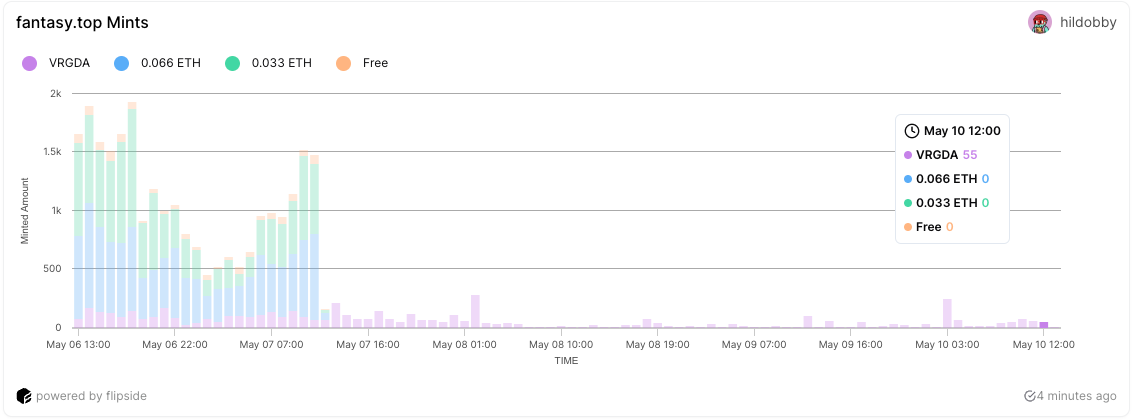
Currently there are about 500-1000ish new cards coming in a day from pack purchases (100-200 packs being purchased per day).
The cost for new packs is determined by a VRGDA or Variable Rate Gradual Dutch Auction. This mechanism was designed by Paradigm, one of the more prominent VC companies in the space (they self-describe themselves as a research-driven technology investment firm).
The tldr of how it’s meant to work is that when there’s a lot of demand, price is high. When there’s not a lot of demand, price lowers. The goal is to keep the emissions at/near a rate that the team believes is healthy and sustainable for the longevity of the game.
Here’s a simple example from the Paradigm post about how it works:
This is one way new supply is created. The other way is that cards are distributed as tournament rewards. The quantity released via tournament rewards will likely be at the team’s discretion and done in a way designed to mitigate over-inflation. For instance with the Main Event tournament finishing today, expectations are for there to be somewhere in the range of 20-40k new cards released.
This seems like a lot but it’s to coincide with a batch of 40 new heroes (i suspect future batches to add far fewer heroes). For reference, the previous tournament only gave out a total of 1,660 cards.
Speaking of new heroes, let’s now talk about how supply works on an individual card basis.
Hero Card Supply Dynamics
Every card has an “inflation” number (from 1-100), and this number is directly related to the rank of the card. The better the rank of the card (and the more stars it has), the lower the inflation number. The lower the inflation number, the less likely the card is to randomly appear as a new mint.
It is designed this way so that the “best” cards appear the least frequently (which in turn means it’s harder to improve their rarity from common → rare → epic → legendary). Remember that it take burning 5x cards to upgrade a rarity level, which means it takes burning 125x common cards (excluding the ~1% luck chance) to create a legendary card.
The most rare card is greg with only 39 cards created. There are no epic greg cards and certainly no legendary greg cards.
The least rare card is palmer with 10,069 cards created.
The difference in supply for different cards creates some strategic dynamics — in a tournament of 18k players, there’s value in being only 1 of a maximum of 40 people who could possibly play a certain card.
Another angle is that for someone with 10,000 cards, they likely have thousands of holders, and they are now incentivized to engage with that person’s content and generally want to see them succeed. Network effects are real.
The team mentioned yesterday that when new heroes are introduced, the mints from new packs and tournament rewards will heavily favor new heroes. To the tune that roughly 80% of all new cards will be for the new heroes. This to me seems like a great mechanism to a) introduce new heroes in a way where they start off with a reasonable supply and b) ensure the earlier cards don’t continue to inflate forever.
Three final interesting things of note regarding supply:
1/ When a tournament is running and a player enters a deck in the tournament, the 5 cards are locked and cannot be listed for sale. Last tournament had ~18k entrants, so 90k cards were locked. It’s likely we see multiple tournaments running at a time, which can create some real supply shock. Especially with different tournament “types”, for instance, a tournament where you can only enter common-only cards.
2/ Allegedly within the smart contract there’s some sort of burn function that could potentially allow the burning of 15x random cards for a chance of minting a brand new card. I’m not sure if this will ever happen or if the 15x number is accurate or set in stone, but it does seem like a promising idea to allow people to burn supply to mint new cards rather than simply upgrade to a higher rarity.
3/ The game launched with 124 heroes. One of the heroes decided they didn’t want to take part any more, so the team burned all their cards. For the players who held their cards, the team minted them a new random card of equal or higher value. We could see this happen more in the future if/when heroes decide not to play any more.
It’s pretty clear that the team has put a lot of thought into the supply dynamics for FT. A lot of people are scared that this is gonna be “topshot 2.0” and it’s certainly possible, but let us hope that they have learned from history. Current signs are optimistic on this front.
Tournament Types, Leagues, and Rewards/Prizes
Alright so we’ve got a bunch of cards out there and a bunch of ways to get the cards, what do you do with them? You can either trade them on the marketplace (will talk about this next), or you can enter them into tournaments.
Since the game is so new, we have only had two tournaments on mainnet. But the game was on testnet for 3 months and so we have a solid understanding of the types of tournaments that could be run:
Open tournaments, all cards can be played
“common only” tournaments, self explanatory, no rare cards
Tournaments where your heroes have less than 50k followers on Twitter
Tournaments where you can only play heroes with an NFT as their PFP on Twitter
etc etc etc
These formats will be designed to make the game continually interesting for players as well as to give as wide a swath of players a chance to use their cards. A whale with all legendary cards has much less of an advantage over a non-whale when the tournament only allows common cards.
In addition to these different tournament types, there are leagues to help even further give everyone a chance at winning.
As you can see there are 5 leagues in total. Bronze, Silver, Gold… Emerald?… Rainbow?
After the Main Event tournament, the bottom 50% of the players remained in Bronze league and the top 50% moved to silver. Over time, the best players will continue to move up and ideally players will settle at a level where they’re competing against others of relative skill & card strength/value.
The higher your league the better the rewards, so there’s an incentive for trying to climb the ranks - but there will be prizes and rewards for the top finishes in every league (and perhaps participation prizes for all).
Prizes can come in the form of ETH, Blast Gold, New cards/packs of cards, “skins” aka aesthetic prizes, and two platform native currencies called “FAN Points” and “Stars”.
The first bunch are self explanatory, what are FAN Points and Stars?
I can only speculate, but based on what other projects have done with their “points” systems, the FAN points might lead to an eventual airdrop. One piece of utility the team has already mentioned is the possibility of using FAN points to vote on who you would like new heroes to be. I could also envision tournaments where there’s an entry fee in FAN points to boost the prizepool of them.
All I know about Stars so far is this bit from their docs:
So it sounds like you accumulate Stars which can be used for entries into a lottery system to win prizes (likely cards/packs and FAN points if I had to guess).
While on the topic of rewards it’s worth quickly mentioning “quests” which are also mentioned in their docs:
So far it doesn’t seem like quests have been properly implemented, but there’s a section on the website under the “rewards” link that looks like this, and you can currently “claim” your daily quest checkmark basically just by logging in once a day and clicking on the button. A lot of “coming soons” though, so watch this space I guess.
Sustainability
A lot has been asked about the sustainability of all of this. Are people going to want to play when the ETH prize rewards dry up, and the Blast Gold carrot isn’t dangling in front of everyone’s heads any more?
Very good questions to be asking. My thoughts:
1/ The team has announced that 45% of all protocol revenue (ie from pack sales) will go directly back into prizepools. That’s a significant amount, but it alone might not make this sustainable forever.
2/ I’m of the mind that the Blast Gold incentives are unlikely to end at the end of May, and there will likely be continued incentives for dapps on Blast given by the Blast team. Whether in “gold” or some other form, I suspect these last longer than expected.
3/ The team mentioned the idea of getting sponsors for tournaments to add prizes to the prizepools. I can easily imagine a tournament sponsored by Kraken, or EigenLayer, or Rollbit, or whoever. When you think about just how much attention the game can potentially get across all of social media, it starts to seem very interesting for the right advertisers.
4/ What I personally am really excited by is the possibility of entry-fee tournaments. I’ve not heard the team speak about this at all so this is 100% speculation on my end, but if you look at the large Daily Fantasy Sports platforms like DraftKings and FanDuel, they run on a model where people pay entry fees and the platform takes a small % rake from the fees but everything else is given back as prizes.
Imagine a scenario where there are multiple tournaments running a week, ranging from a 0.1 ETH ($300) to a 0.001 ETH ($3) buy-in. Something for everyone. You can have tournaments where the top 10% of people get the prize money, or what’s referred to as “50:50” tournaments where half the people basically double their money and the other half lose their entry.
You can also have Freerolls. Everyone can enter, and maybe there are some small prizes available for the top finishers. I bet a tonne of people would play for free if they got to use mock-cards and the top 10 finishers got a free pack. Get 50,000 entrants in such a tournament and now we’re really talking.
I’m not sure how feasible this is and there’s probably a gambling license required somewhere along the way here, but ultimately it’s a game of skill. Similar to other Fantasy Sports games, or even poker.
The Marketplace
Most of the above has been focused on the mechanics of how the game itself works. There’s a whole other meta-game which involves card collection and trading/flipping.
FT has it’s own native marketplace where cards can be listed for sale or bought, as well as where bids can be placed and accepted.
Just like any NFT marketplace, there is money to be made for savvy traders. Everything from arbitrage opportunities to picking/finding who you think are undervalued heroes and flipping them for a profit.
There’s even already talk of there being a PnL leaderboard for trading cards hah:
This Newsletter is giga long already and it’s getting late here so maybe i’ll leave in-depth strategy for a follow up letter, but a few thoughts on trading / accumulating cards and things to keep in mind:
1/ All else being equal, you always want commons, and you should never upgrade your commons unless you have an immediate and explicit reason for doing so. You can always upgrade later, you can never un-upgrade. The benefits of keeping your cards as commons are that a) there’s tremendously more liquidity in case you want to sell, b) in case of a Blast Jackpot or other airdrop that might be per-token base you get a much higher allocation, and c) you will be able to enter a “common-only” tournament. You should upgrade if you want to enter the rarer card in a tourney, or if you think you can immediately sell the more-rare card for a profit (ie if there’s a bid on a rare/epic/legendary at an overvalued priced), or if you want to gamble gamble for the 1.1% chance for a super upgrade.
2/ Think about why you’re buying a card before you buy it. This sounds extremely obvious, but you’d be shocked at how many people gloss over this step and go “oh I like this person, i’ll buy their card”. This is a game so if you use your brain you can outthink other people and get an advantage. Think about whether a card is overpriced or underpriced. Is the person on vacation now making their stats bad but they’ll be back soon and likely to post higher numbers? Is the algorithm potentially going to change to favor certain cards? Etc.
3/ The most important factor, to me, is “is the hero playing the game”? There are certain heroes who don’t give a shit about the game (it seems). They’re showing a lack of interest in building their own decks, a lack of interest in engaging with the game on Twitter, etc. These heroes can be good buys under certain circumstances (ie their average numbers are great and you’re getting them at a good price), but generally speaking, I think you want someone who’s into the game, perhaps someone competitive, someone who’s taking initiative to follow the meta, understand the algorithm, and so on.
4/ Consider your different deck types. As mentioned earlier, there are going to be different types of tournaments. Only commons, only NFT PFPs, sub 50k followers, and probably dozens more to be introduced. Keep an eye on the tournament types and consider if there are certain heroes that check 2 or 3 or 4 boxes and can be entered in almost every tournament vs perhaps niche heroes who would only do well under very limited conditions.
5/ Data is your friend. This game has only been out a week but people have already started creating amazing analytics dashboards. Here are a few:
Look up the supply of cards. Look up the total overall views people are getting. How many tweets they’re sending. Compare their prices to other heroes of similar stats — is someone underpriced? Are a whole group of people overpriced? Do some research or you’ll lose out to the people who are doing their research.
A few people I recommend following on Twitter for some good FantasyTop content:
Last thoughts on the marketplace and buying/selling/trading/holding cards are to implore you to please be responsible. I’m giga bullposting about FT and so are so many others, but all of us Heroes make money when there’s volume on the site and we’re incentivized for activity to take place. I am genuinely bullish and think prices can appreciate, but I have been around long enough to know that it doesn’t take much for an app to fall out of favor and for attention to wane and migrate elsewhere.
That might happen, it might not happen, but it is entirely possible and potentially even likely for the prices of cards to drop 90%+ from here.
If you’re trying to make money from this, create a sound strategy and manage your bankroll and risk please.
Getting Started
Well if you’ve made it this far & are still interested & want to get started, it’s relatively easy to make an account.
Head to https://www.fantasy.top/
Click “log in with X” and authorize the app
Accept the T&Cs
You’ll need to enter an invite code to get access still, mine is ‘zeneca’
Voila! Account created.
What happened magically on the back end is that a brand new Ethereum wallet was created for you using something called Privy. You should see your address now on the screen (and can see it whenever you log in). You’ll need to send funds to your wallet to get started (a minimum of 0.001 ETH), and you’ll need to send the ETH from Blast.
I recommend signing up and bridging via the Blast homepage so you can start accruing points/gold.
You can also bridge to Blast using an exchange such as Bungee or Orbiter.
IMPORTANT SECURITY STUFF
Make sure you have 2FA (two-factor authentication) set up on your Twitter account. Since your wallet is connected to your Twitter, if someone hacks your Twitter account they can access your FT account + wallet in the app.
I also highly recommend exporting your private key. You’ll see an option to do this when you’re setting up your account, but you can also do it by clicking on your profile in the top right corner and going to Security > Export Wallet.
Save this somewhere secure ideally not electronically.
That’s about it for getting signed up, start poking around the site and take it from there.
Where to from here? Predictions…
I’ve written a lot but at the same time there’s so much I didn’t cover despite wanting to. I might not have hammered it home enough but this game is FUN. It’s sticky, it’s engaging, it’s rewarding, it’s exciting, it’s interesting, it’s difficult, it’s complex, it’s strategic, it’s constantly changing, it’s social, it’s viral, it’s financial, it’s emotional, it’s random, it’s skillful.
It has a tremendous amount going for it. It creates an incredible positive-feedback-loop flywheel due to being run on top of Twitter, whereby the heroes are incentivized to create strong content and post frequently, and their card holders are incentivized to engage with their content.
One of the beautiful things is it allows creators a new avenue for receiving financial rewards in exchange for content creation that doesn’t inherently require them to significantly (if at all) change their content creation strategy.
Most heroes are just doing what they’ve always done: vibe out on Twitter.
Back in September 2023 I wrote a similar-length Newsletter on the other FT: Friend Tech. I thought it was interesting and that there was money to be made on it, but I didn’t think the app had the longevity required to stick around long term. It seemed like a ponzi first and socialfi app second.
Near the end of that Newsletter I said the following:
Friend Tech might “make it” long term. It really might. There’s something novel, fun, interesting, profitable, engaging, and rewarding about the entire experience.
The deck is heavily stacked against it, though, and it is again my opinion that almost certainly the prices of almost everything are going to drop significantly.
The questions you should ask are:
Is it sustainable?
Is it better than web2 options?
Is the fun and excitement and engagement going to be there when the airdrop farming goes away?
When prices go down?
You can think and answer those yourself.
My personal strategy is going to be to have fun while it lasts, engage with the people in my room for as long as people want to hang out in there with me, and treat the whole thing like an interesting experiment and learning experience.
Even if FT doesn’t work out, I think it is a really great step in the direction of creating a DeSo / SoFi ecosystem that rewards creators. We are living in the creator economy after all.
Overall I was not particularly convinced on it, but I did think it was perhaps a stepping stone in the right direction. They had struck a nerve somewhere.
Well now many months later I think that Farcaster is the best Decentralized Social Media app we have and am a huge fan of it, strongly believing it’s the future of social media (albeit it might take a decade).
And I have a growing amount of conviction that FantasyTop might have cracked the SocialFinance puzzle and created a game that is fun first and financial second.
It’s all well and good to say this now when incentives are showering down on us and basically everyone is making money. What’s it gonna be like when the music stops? When we hit a bit of a bear market, or a brutal bear market? Is Fantasy the flavor of the month and will everyone flock to memecoins on Base next month and leave FT in the dust? Or does it have what it takes to “make it”, to succeed where oh so many others failed?
It’s obviously impossible to know the answer to these questions. And the deck might be stacked against FT. And I am obviously biased. But I like to think I have built a level of trust in the 3 years I have been writing this Newsletter where I disclose my vested interests in things and share my honest thoughts — ie with FriendTech I had a bunch of money in the protocol but didn’t give it a glowing review.
So when I say I haven’t felt this bullish on anything in crypto since 2021, I really mean it. Bullish is not infallible. I have been bullish and wrong many times. But my god am I having the time of my life playing this game, and I feel surrounded by thousands of others who feel the same way.
In my February Newsletter on Farcaster I proclaimed that it really felt like this time it was different for Decentralized Social. I still feel the same way: Farcaster growth has exploded and the ecosystem continues to thrive.
At the hubristic risk of angering the gods, I’ll be going back-to-back and doubling down by saying this time it fucking feels different too except for the world of Social Finance.
I think FantasyTop has cracked the nut.
A fun and financialized layer on top of existing social media.
The deck might be stacked against them, but if they play their cards right, I think they just might have staying power.
Disclaimer: The content covered in this newsletter is not to be considered as investment advice. I’m not a financial adviser. These are only my own opinions and ideas. You should always consult with a professional/licensed financial adviser before trading or investing in any cryptocurrency related product. This Newsletter may contain referral links whereby I receive rewards for people who sign up via my link or code.
Disclosure: I am an angel investor in FantasyTop and an active player with 500+ cards that I purchased with my own funds.

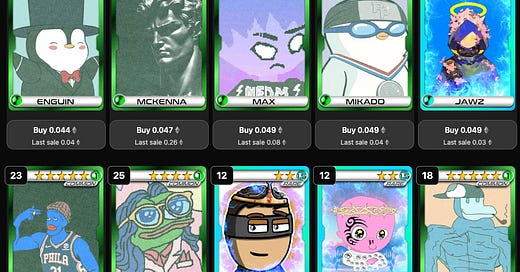




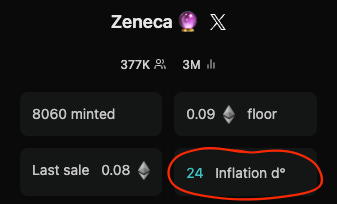


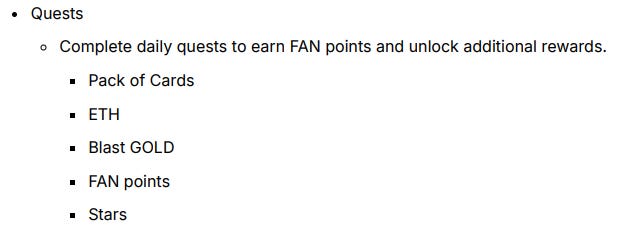
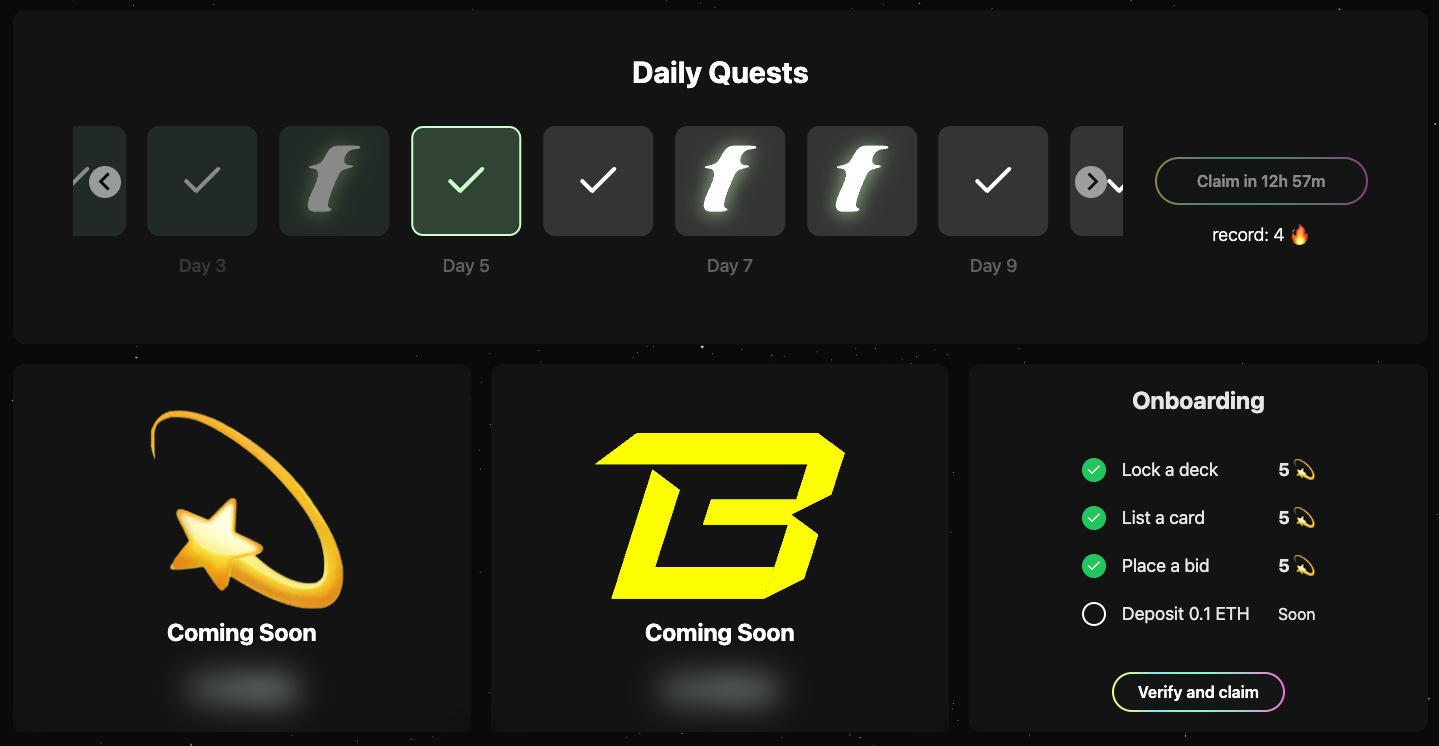

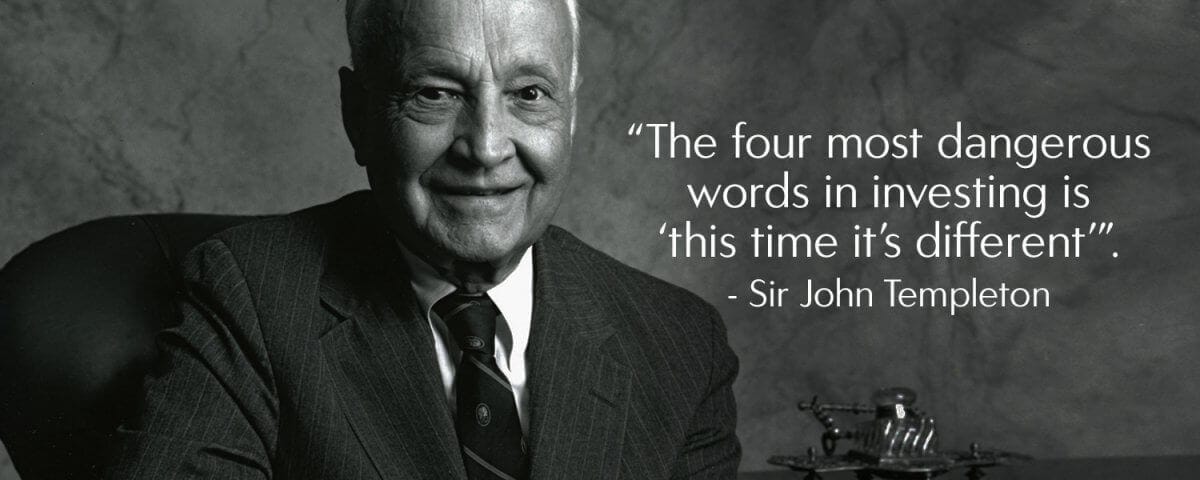
GM, excellent and helpful articulation, however, what's with all the animosity towards "living under a tree" !
Living under a tree can be so much more rewarding than slaving in front of a screen all day trying to guess and outguess and correct and keep a tally and pvp and etc.
Yeah, I prefer the tree, happier more relaxing, better quality and longer life!! 🖖🏽👍🏽
What a gem of article